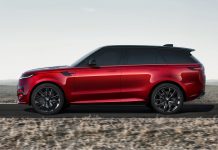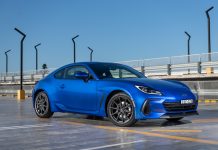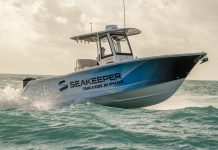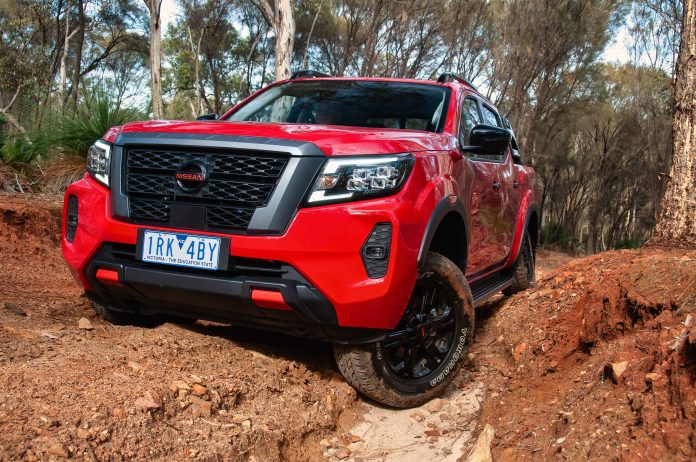If you want to turn heads, with bold new strong front-end styling, Nissan’s latest Navara is instantly recognisable. Taking prominent design cues from its bigger US sibling, the monstrous Titan pickup, this modern interpretation for the Aussie market has given the Navara its own unique look that generates more than the occasional fleeting glance.
Our test vehicle, a Navara PRO-4X finished in a striking red and black athletic colour scheme, had a hulking interlocked radiator grill that dominated the front end. Flanked by space age quad cubed LED projector headlamps, it gave this new Navara muscular and assertive good looks. With accented black door handles, roof rails, wing mirrors, rugged alloy wheels, side steps and brawny rear bar work, whose side panels looked like they’d come from a Meccano set; the combination of strong black on red contrasts and large PRO-4X decals added to the vehicle’s resolute good looks.
However, the magma orange tinted highlights featured on the front nose cone and wheel arch flares might look OK against the alternative PRO-4X option of Stealth Grey, but were an odd juxtaposition on the burning red as they looked like faded plastic.
Walking around the side, what’s this? Oh, be still my beating heart. Practical 17” wheels with 255/65R17 Yokohama Geolander all-terrain tyres, suitable for moderate 4WDrive excursions, straight off the showroom floor on a blinged up dual cab with cool street cred… nice! Not only will you enjoy the availability of a much larger selection of brands, tyre construction and tread patterns, but your odds of being able to get an emergency spare back of beyond have significantly increased.
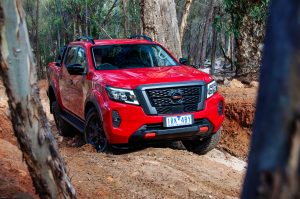
As indestructible as the PRO-4X exterior looks might be, before you go tackling that forgotten trail to Skull Mountain, consider those lightweight side steps and the hard plastic mud flaps that provide some protection from gravel stones or mud splashes. Neither will withstand firm contact with a rock ledge or bolder.
I also appreciated the practicality of handy roof rails up top, and that Nissan has included a tow bar as standard on the PRO-4X. Rated with a braked towing capacity of 3500kgs and a tow ball weight of 350kg, the Navara will place you in good stead for towing duties. There is a rear tub liner for durability, with an assisted tail gate for ease of operation. The tail gate itself houses the reversing camera and has a uniquely styled Nissan badge with the Navara nameplate elegantly embossed across the bottom of the door, all nicely framed between the modern slick rear LED taillights.
There’s four solid tie down points in the tub, plus those clever adjustable side rails for awkward loads. Payload is 1004kg minus tow ball weight and any accessories you install. The rear sports bar has an inbuilt high mount stop light, but it’s more decorative than commercially functional. You could mount a few camp lights on it; I wouldn’t strap on a heavy load. The rear bumper is colour coded and provides a level step for easy rear access. The PRO-4X has a rear camera and parking sensors out back, but no sensors on the front—something I thought would have been standard given the rest of the spec.
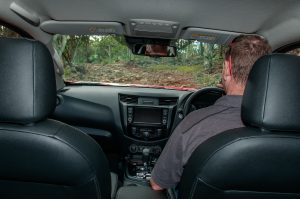
Open the driver’s door and the PRO-4X interior is inviting with sporty quilted front and rear leather seats; the white stitching in the center nicely contrasted against the red stitching along the middle of the bolsters and completed by a PRO-4X decal on the top right corner of the backrests. The floor coverings weren’t standing up well to heavy-booted test drivers and were already showing some wear; a decent set of rubber mats to protect your investment would be a good idea.
Driver comfort is an important factor, especially if you’re going to be spending an inordinate amount of time behind the wheel. Disappointing was the lack of any power adjustment or heating on either front seat. In one of those weird spec variations; at the time I wrote this, it was only available as an option pack on the less expensive ST-X variant. But the Navara still gains comfort points.
The front seats are comfortable and supportive despite being relatively flat on the base and backrest. You don’t feel restricted or as though you need to squish yourself into them, which will be a welcome change for those who are broader across the shoulders. Plus, it makes ingress and egress easy.

As a conscious driver who regularly eyeballs the dash for status; I liked how Nissan has kept the instrumentation clear and uncluttered. The 7” TFT screen between the speedo and tacho provides a good array of driver information that’s easy to navigate. You can see what you need at a glance because of the crisp white backlighting, so you don’t have to study it. The designers considered ergonomics, with a logical arrangement or easy reach controls and buttons. The parking sensors, rear diff lock, hill descent and rotary dial to select the various 4wdrive modes 2H, 4H and 4L are conveniently located under the dual climate AC heating controls with a small toggle switch on the console next to the gear lever to operate the various drive modes. And the newly designed steering wheel looks and feels the part with audio, phone, and menu operation for the center screen.
The 8” center touch screen, housed in a smart piano black surround, has shortcut buttons on the side and a welcome rotary knob for volume control. Connecting my phone was a doddle and having either option for Apple Car Play or Android Auto, I could quickly enable GPS navigation, stream my audio, or use voice recognition. Not that I bothered, but you can even customize the display like you would your iPad or tablet.
There are good solid grab handles on all door openings, except for the driver. A gentle tug on the steering wheel to pull yourself in is easy enough in a car park. But not so good after doing some track building and needing to haul yourself back in with the door handle level with your face!
Nissan has revised both the base and backrest of the rear seats for improved passenger comfort. But rear seat leg room isn’t abundant; the front seats have flat backs with no recess, so taller passengers may find it a bit of a squeeze. There’s reasonable head and foot room to slide your feet under the front seats, with adjustable headrests and a fold down arm rest. But don’t expect anyone to sit in the middle for anything more than a quick trip, as they won’t thank you for it.
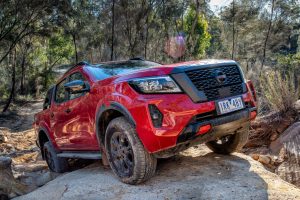
Under the very heavy hood is the same 2.3L inter-cooled twin turbo diesel as fitted to the previous model. Coupled to a seven-speed auto, the combination works well around town, making light work of suburban daily duties or annoying stop start city traffic. There’s a slight softness to throttle response as you move off the line, but power builds progressively, allowing you to tap into the lusty 450Nm of torque from as early as 1500rpm, which is an ideal characteristic for comfortable towing. But, if you stand on the throttle and let the seven speeds exploit the torque, it keeps the 2.3L on the boil, and the PRO-4X will instigate a hasty response allowing confident, merging into fast-paced freeway traffic, or getting past that cattle truck on the country roads.
Nissan claims a fuel consumption of just over 8L/100km. Given our city, suburban, country, and off-road adventures, we managed closer to 10L/100km. With an 80L tank onboard, that should see you on the right side of an 800 km range—especially if the balance is highway cruising.
After a long drive on the blacktop, I really appreciated how well insulated the cabin was from external noise. It’s no sound booth, and you can still hear what’s going on around you. It’s just the quieter interior of the PRO-4X contributed to a relaxed ride, which is important for reducing driver fatigue on long hauls. A nice touch is the electric rear glass allowing you to open the cabin for flow through ventilation.
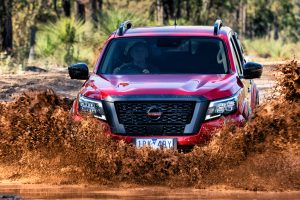
What impressed me was the latest suspension calibration on the Navara. The independent double-wishbone front end works well with the old school hydraulic rack and pinion steering. It’s nicely weighted so you don’t feel you’re driving a truck; there’s no sports car accuracy, but its slightly slower response pays dividends when off-road. The PRO-4X’s turn in on corners is confidently reassuring, and those all-terrain tyres will make their disapproval known well before any serious under-steer should you be a little overzealous with the right boot.
Nissan has really dialed in the advantages of coil rear springs, with reduced transference of rear axle oscillation and further settling to a typical unladen dual cab tail wiggle. Yet they have kept a respectable payload capacity thanks, in part, to the newly strengthened rear end. On road the suspension soaks up all but the biggest of bumps, to hush past criticisms of earlier configurations.
Braking is progressive and you can pull on the reins firmly when needing to arrest the PRO-4X’s momentum. But why run drum brakes on the rear of modern family-oriented dual cabs? This is not a truck. Drum brakes are a cheaper and easier alternative for manufacturers, but disc rotors have advantages for 4WDrives beyond better braking performance, such as centrifugal cleaning to disperse water, mud and sand that contributes to longevity and reliability. Why do you think Toyota’s heavy haulage 70 series ute has been using rear disc brakes since the early 90s?
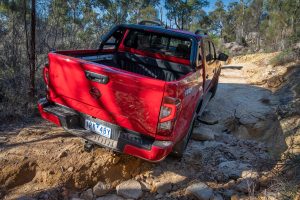
Having the confidence to fit all-terrain tyres to the PRO-4X as standard, hinted at Nissan’s confidence in this vehicle’s off-road capability. A confidence that was well founded.
On fast gravel work with potholes and corrugations, the Navara’s coil sprung rear end excelled over its leaf sprung counterparts. The ride and control for an empty dual cab ute are noteworthy. Leaf springs are the dominant force for load carrying and can achieve significant flex if setup correctly. But they can’t compete for on road ride control, handling and custom tuning or articulation. How many off-road racers have you seen with leaf springs?
As good as the auto trans is around town; when I want manual control to maintain vehicle stability on extremely challenging terrain, having the transmission determine when it’s appropriate to up or down shift, irrelevant of my input from the gear shift leaver, can be a little concerning as you tip the front end over a greasy slick mud-covered hill. To its saving grace, the hill decent control system works very well and if you convince the auto to abide by your decision, it will hold that gear with the tenacity of a crocodile locking on to a frozen chicken.
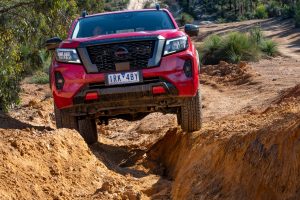
Another impressive aspect of the PRO-4X was its wheel articulation. Without the advantage of putting it head-to-head with a competitor on the same day but following the same test track I’ve put others through; the Navara maintained contact with terra firma for longer, allowing it to crawl through where others had struggled. When wheels lifted, the traction control was a little slow to react, which caused it to falter and work harder than expected. But engaging the rear diff lock saw the PRO-4X push through, convincingly maintaining driver confidence in tricky situations.
With ground clearance of 220mm, driving across broken rocky terrain required a little care not to get hung up on larger rocks. Having everything underneath well tucked up out of harm’s way was reassuring. With careful wheel placement and moderate throttle input, the low range gearing afforded good control, metering engine torque successfully to negotiate some difficult obstacles that required a little track building intervention. The approach, departure, and ramp over angles of 32, 19.8 and 22.9 respectively, offer reasonable capability to negotiate most moderate off-road challenges. Just remember to slip the tongue out of the tow hitch before heading into the rough stuff.
Nissan has provided four drive modes to optimize the vehicle for various driving conditions, including standard, tow, sport and off-road. Tow, sport, and standard are available in 2H with H4 enabling off-road mode. But here’s the oddity, select 4L for challenging conditions and the PRO-4X selects standard mode by default. I couldn’t test tow mode, but sport was too aggressive, simply making the little diesel wring its neck through the gears in a way that was uncomfortable and unnecessary. Off-road mode didn’t provide any appreciable benefit in 4H; given the terrain I was driving, my preference was standard mode and manually change the gears.
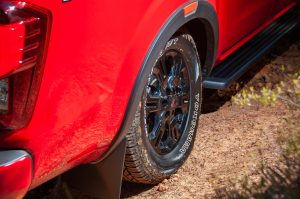
I appreciated Nissan’s surround camera functionality as it’s ideal for performing tight manoeuvres in limited space, and the fact you could select the forward-facing camera with trajectory lines was handy. When off-road, the screen displayed the passenger’s front wheel and the forward view, providing a good reference for wheel placement. I’m not sure why the driver’s side wheel wasn’t displayed given there’s a camera in the driver’s mirror. But the quality of the image was a little softer than the PRO-4X’s rivals.
Storage is OK with bottle holders on the doors, but the console bin isn’t overly large. There’s plenty of connectivity with a 12v outlet and USB up front, an additional USB and USBc inside the console, and a rear USB with dual AC vents built into the back of the console for rear passenger comfort and convenience.
The Navara holds a 5-star ANCAP safety rating from previous generations, there’s two ISOFIX anchorage points in the rear, seven air bags, autonomous emergency braking, land departure, forward collision, blind spot and rear cross traffic warnings. A benefit for touring and off-road driving will be Nissan’s trailer sway control, hill start assist and hill descent control.
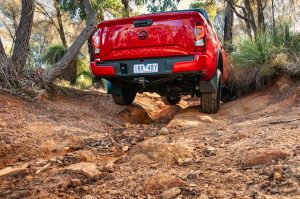
The PRO-4X felt more formidable on the road than its physical dimensions would suggest. It’s a perception you get from behind the wheel; there’s no one thing you can put your finger on but a combination of factors including the seating, interior layout, outward visibility over its dimensions and the way its steering and suspension react convey a reassuring bulk. Some factory rated recovery points, real rock sliders and the power of a V6 would be nice, but I guess we’ll have to wait and see what the new Navara PRO-4X Warrior will bring.
Fast Facts:
Price: $62,290
Engine: 2.3L twin turbo diesel engine
Output: 140kW/450Nm
Transmission: Seven-speed automatic
Fuel: 8.1L/100km
Safety rating ANCAP 5 Stars.


